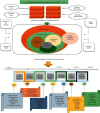Application of Artificial Intelligence in Discovery and Development of Anticancer and Antidiabetic Therapeutic Agents
- PMID: 35509623
- PMCID: PMC9060979
- DOI: 10.1155/2022/6201067
Application of Artificial Intelligence in Discovery and Development of Anticancer and Antidiabetic Therapeutic Agents
Retraction in
-
Retracted: Application of Artificial Intelligence in Discovery and Development of Anticancer and Antidiabetic Therapeutic Agents.Evid Based Complement Alternat Med. 2023 Aug 9;2023:9782318. doi: 10.1155/2023/9782318. eCollection 2023. Evid Based Complement Alternat Med. 2023. PMID: 37593011 Free PMC article.
Abstract
Spectacular developments in molecular and cellular biology have led to important discoveries in cancer research. Despite cancer is one of the major causes of morbidity and mortality globally, diabetes is one of the most leading sources of group of disorders. Artificial intelligence (AI) has been considered the fourth industrial revolution machine. The most major hurdles in drug discovery and development are the time and expenditures required to sustain the drug research pipeline. Large amounts of data can be explored and generated by AI, which can then be converted into useful knowledge. Because of this, the world's largest drug companies have already begun to use AI in their drug development research. In the present era, AI has a huge amount of potential for the rapid discovery and development of new anticancer drugs. Clinical studies, electronic medical records, high-resolution medical imaging, and genomic assessments are just a few of the tools that could aid drug development. Large data sets are available to researchers in the pharmaceutical and medical fields, which can be analyzed by advanced AI systems. This review looked at how computational biology and AI technologies may be utilized in cancer precision drug development by combining knowledge of cancer medicines, drug resistance, and structural biology. This review also highlighted a realistic assessment of the potential for AI in understanding and managing diabetes.
Copyright © 2022 Amal Alqahtani.
Conflict of interest statement
The author declares that there are no conflicts of interest.
Figures



Similar articles
-
Application of Computational Biology and Artificial Intelligence Technologies in Cancer Precision Drug Discovery.Biomed Res Int. 2019 Nov 11;2019:8427042. doi: 10.1155/2019/8427042. eCollection 2019. Biomed Res Int. 2019. PMID: 31886259 Free PMC article. Review.
-
Trends of Artificial Intelligence (AI) Use in Drug Targets, Discovery and Development: Current Status and Future Perspectives.Curr Drug Targets. 2025;26(4):221-242. doi: 10.2174/0113894501322734241008163304. Curr Drug Targets. 2025. PMID: 39473198 Review.
-
Application of Artificial Intelligence in Drug Discovery.Curr Pharm Des. 2022;28(33):2690-2703. doi: 10.2174/1381612828666220608141049. Curr Pharm Des. 2022. PMID: 35676841 Review.
-
Artificial Intelligence in Drug Discovery: A Comprehensive Review of Data-driven and Machine Learning Approaches.Biotechnol Bioprocess Eng. 2020;25(6):895-930. doi: 10.1007/s12257-020-0049-y. Epub 2021 Jan 7. Biotechnol Bioprocess Eng. 2020. PMID: 33437151 Free PMC article. Review.
-
Artificial Intelligence (AI) in Drugs and Pharmaceuticals.Comb Chem High Throughput Screen. 2022;25(11):1818-1837. doi: 10.2174/1386207325666211207153943. Comb Chem High Throughput Screen. 2022. PMID: 34875986
Cited by
-
Progress and challenges for the application of machine learning for neglected tropical diseases.F1000Res. 2025 Jul 17;12:287. doi: 10.12688/f1000research.129064.3. eCollection 2023. F1000Res. 2025. PMID: 40642109 Free PMC article. Review.
-
Rise of Deep Learning Clinical Applications and Challenges in Omics Data: A Systematic Review.Diagnostics (Basel). 2023 Feb 10;13(4):664. doi: 10.3390/diagnostics13040664. Diagnostics (Basel). 2023. PMID: 36832152 Free PMC article. Review.
-
From molecular mechanisms of prostate cancer to translational applications: based on multi-omics fusion analysis and intelligent medicine.Health Inf Sci Syst. 2023 Dec 18;12(1):6. doi: 10.1007/s13755-023-00264-5. eCollection 2024 Dec. Health Inf Sci Syst. 2023. PMID: 38125666 Review.
-
Retracted: Application of Artificial Intelligence in Discovery and Development of Anticancer and Antidiabetic Therapeutic Agents.Evid Based Complement Alternat Med. 2023 Aug 9;2023:9782318. doi: 10.1155/2023/9782318. eCollection 2023. Evid Based Complement Alternat Med. 2023. PMID: 37593011 Free PMC article.
References
-
- Chen W., Zheng R., Baade P. D., et al. Cancer statistics in China. CA: a cancer journal for clinicians . 2015;66(2):115–132. - PubMed
-
- Mak L., Liggi S., Tan L., et al. Anti-cancer drug development: computational strategies to identify and target proteins involved in cancer metabolism. Current Pharmaceutical Design . 2013;19(4):532–577. - PubMed
-
- Das S. K., Bhutia S. K., Kegelman T. P., et al. MDA-9/syntenin: a positive gatekeeper of melanoma metastasis. Frontiers in Bioscience . 2016;17(1):1–15. - PubMed
Publication types
LinkOut - more resources
Full Text Sources

